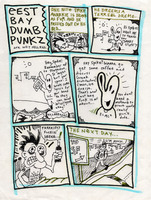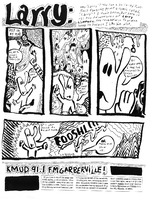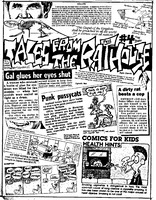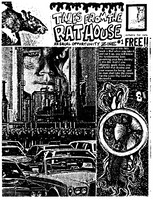Items
Relation is exactly
Potatomen
-
 Puddle #7 Puddle was a personal zine mostly written, edited and designed by Chris Appelgren, from 1988 to 1994, covering topics such as music, the Humboldt County and San Francisco punk communities, featuring contributions from Lawrence Livermore, Abe Ringstaff, Theo Robinson, and Robert Eggplant, among others. Appelgren – also known as Chrisser and Chris Appelcore – worked for Lookout Records in several capacities starting in 1988, eventually graduating to owner and president in 1997, when Livermore and Patrick Hynes left the label. Appelgren has created original artwork for many East Bay bands (including Blatz, Green Day, Screeching Weasel, Mr. T Experience, and The Queers) and performed as a musician in The Potatomen, The Lefties, The Pattern, The PeeChees, and Bumblescrump.
Puddle #7 Puddle was a personal zine mostly written, edited and designed by Chris Appelgren, from 1988 to 1994, covering topics such as music, the Humboldt County and San Francisco punk communities, featuring contributions from Lawrence Livermore, Abe Ringstaff, Theo Robinson, and Robert Eggplant, among others. Appelgren – also known as Chrisser and Chris Appelcore – worked for Lookout Records in several capacities starting in 1988, eventually graduating to owner and president in 1997, when Livermore and Patrick Hynes left the label. Appelgren has created original artwork for many East Bay bands (including Blatz, Green Day, Screeching Weasel, Mr. T Experience, and The Queers) and performed as a musician in The Potatomen, The Lefties, The Pattern, The PeeChees, and Bumblescrump. -
 Puddle #5 Puddle was a personal zine mostly written, edited and designed by Chris Appelgren, from 1988 to 1994, covering topics such as music, the Humboldt County and San Francisco punk communities, featuring contributions from Lawrence Livermore, Abe Ringstaff, Theo Robinson, and Robert Eggplant, among others. Appelgren – also known as Chrisser and Chris Appelcore – worked for Lookout Records in several capacities starting in 1988, eventually graduating to owner and president in 1997, when Livermore and Patrick Hynes left the label. Appelgren has created original artwork for many East Bay bands (including Blatz, Green Day, Screeching Weasel, Mr. T Experience, and The Queers) and performed as a musician in The Potatomen, The Lefties, The Pattern, The PeeChees, and Bumblescrump.
Puddle #5 Puddle was a personal zine mostly written, edited and designed by Chris Appelgren, from 1988 to 1994, covering topics such as music, the Humboldt County and San Francisco punk communities, featuring contributions from Lawrence Livermore, Abe Ringstaff, Theo Robinson, and Robert Eggplant, among others. Appelgren – also known as Chrisser and Chris Appelcore – worked for Lookout Records in several capacities starting in 1988, eventually graduating to owner and president in 1997, when Livermore and Patrick Hynes left the label. Appelgren has created original artwork for many East Bay bands (including Blatz, Green Day, Screeching Weasel, Mr. T Experience, and The Queers) and performed as a musician in The Potatomen, The Lefties, The Pattern, The PeeChees, and Bumblescrump. -
 Puddle #3 Puddle was a personal zine mostly written, edited and designed by Chris Appelgren, from 1988 to 1994, covering topics such as music, the Humboldt County and San Francisco punk communities, featuring contributions from Lawrence Livermore, Abe Ringstaff, Theo Robinson, and Robert Eggplant, among others. Appelgren – also known as Chrisser and Chris Appelcore – worked for Lookout Records in several capacities starting in 1988, eventually graduating to owner and president in 1997, when Livermore and Patrick Hynes left the label. Appelgren has created original artwork for many East Bay bands (including Blatz, Green Day, Screeching Weasel, Mr. T Experience, and The Queers) and performed as a musician in The Potatomen, The Lefties, The Pattern, The PeeChees, and Bumblescrump.
Puddle #3 Puddle was a personal zine mostly written, edited and designed by Chris Appelgren, from 1988 to 1994, covering topics such as music, the Humboldt County and San Francisco punk communities, featuring contributions from Lawrence Livermore, Abe Ringstaff, Theo Robinson, and Robert Eggplant, among others. Appelgren – also known as Chrisser and Chris Appelcore – worked for Lookout Records in several capacities starting in 1988, eventually graduating to owner and president in 1997, when Livermore and Patrick Hynes left the label. Appelgren has created original artwork for many East Bay bands (including Blatz, Green Day, Screeching Weasel, Mr. T Experience, and The Queers) and performed as a musician in The Potatomen, The Lefties, The Pattern, The PeeChees, and Bumblescrump. -
 Puddle #1 Puddle was a personal zine mostly written, edited and designed by Chris Appelgren, from 1988 to 1994, covering topics such as music, the Humboldt County and San Francisco punk communities, featuring contributions from Lawrence Livermore, Abe Ringstaff, Theo Robinson, and Robert Eggplant, among others. Appelgren – also known as Chrisser and Chris Appelcore – worked for Lookout Records in several capacities starting in 1988, eventually graduating to owner and president in 1997, when Livermore and Patrick Hynes left the label. Appelgren has created original artwork for many East Bay bands (including Blatz, Green Day, Screeching Weasel, Mr. T Experience, and The Queers) and performed as a musician in The Potatomen, The Lefties, The Pattern, The PeeChees, and Bumblescrump.
Puddle #1 Puddle was a personal zine mostly written, edited and designed by Chris Appelgren, from 1988 to 1994, covering topics such as music, the Humboldt County and San Francisco punk communities, featuring contributions from Lawrence Livermore, Abe Ringstaff, Theo Robinson, and Robert Eggplant, among others. Appelgren – also known as Chrisser and Chris Appelcore – worked for Lookout Records in several capacities starting in 1988, eventually graduating to owner and president in 1997, when Livermore and Patrick Hynes left the label. Appelgren has created original artwork for many East Bay bands (including Blatz, Green Day, Screeching Weasel, Mr. T Experience, and The Queers) and performed as a musician in The Potatomen, The Lefties, The Pattern, The PeeChees, and Bumblescrump. -
 Phobia
Phobia
-
 More Larry & Trip!
More Larry & Trip!
-
 East Bay Dumb Punkz
East Bay Dumb Punkz
-
 East Bay Comix
East Bay Comix
-
 Larry #2
Larry #2
-
 Larry #1
Larry #1
-
 Can of Pork
Can of Pork
-
 Poems Inspired by Rancid Written for an unpublished fanzine project.
Poems Inspired by Rancid Written for an unpublished fanzine project. -
 Comitbust #36 Comitbust was a satire of Cometbus fanzine
Comitbust #36 Comitbust was a satire of Cometbus fanzine -
 Puddle #9 Puddle was a personal zine mostly written, edited and designed by Chris Appelgren, from 1988 to 1994, covering topics such as music, the Humboldt County and San Francisco punk communities, featuring contributions from Lawrence Livermore, Abe Ringstaff, Theo Robinson, and Robert Eggplant, among others. Appelgren – also known as Chrisser and Chris Appelcore – worked for Lookout Records in several capacities starting in 1988, eventually graduating to owner and president in 1997, when Livermore and Patrick Hynes left the label. Appelgren has created original artwork for many East Bay bands (including Blatz, Green Day, Screeching Weasel, Mr. T Experience, and The Queers) and performed as a musician in The Potatomen, The Lefties, The Pattern, The PeeChees, and Bumblescrump.
Puddle #9 Puddle was a personal zine mostly written, edited and designed by Chris Appelgren, from 1988 to 1994, covering topics such as music, the Humboldt County and San Francisco punk communities, featuring contributions from Lawrence Livermore, Abe Ringstaff, Theo Robinson, and Robert Eggplant, among others. Appelgren – also known as Chrisser and Chris Appelcore – worked for Lookout Records in several capacities starting in 1988, eventually graduating to owner and president in 1997, when Livermore and Patrick Hynes left the label. Appelgren has created original artwork for many East Bay bands (including Blatz, Green Day, Screeching Weasel, Mr. T Experience, and The Queers) and performed as a musician in The Potatomen, The Lefties, The Pattern, The PeeChees, and Bumblescrump. -
 Puddle #4 Puddle was a personal zine mostly written, edited and designed by Chris Appelgren, from 1988 to 1994, covering topics such as music, the Humboldt County and San Francisco punk communities, featuring contributions from Lawrence Livermore, Abe Ringstaff, Theo Robinson, and Robert Eggplant, among others. Appelgren – also known as Chrisser and Chris Appelcore – worked for Lookout Records in several capacities starting in 1988, eventually graduating to owner and president in 1997, when Livermore and Patrick Hynes left the label. Appelgren has created original artwork for many East Bay bands (including Blatz, Green Day, Screeching Weasel, Mr. T Experience, and The Queers) and performed as a musician in The Potatomen, The Lefties, The Pattern, The PeeChees, and Bumblescrump.
Puddle #4 Puddle was a personal zine mostly written, edited and designed by Chris Appelgren, from 1988 to 1994, covering topics such as music, the Humboldt County and San Francisco punk communities, featuring contributions from Lawrence Livermore, Abe Ringstaff, Theo Robinson, and Robert Eggplant, among others. Appelgren – also known as Chrisser and Chris Appelcore – worked for Lookout Records in several capacities starting in 1988, eventually graduating to owner and president in 1997, when Livermore and Patrick Hynes left the label. Appelgren has created original artwork for many East Bay bands (including Blatz, Green Day, Screeching Weasel, Mr. T Experience, and The Queers) and performed as a musician in The Potatomen, The Lefties, The Pattern, The PeeChees, and Bumblescrump. -
 Puddle #2 Puddle was a personal zine mostly written, edited and designed by Chris Appelgren, from 1988 to 1994, covering topics such as music, the Humboldt County and San Francisco punk communities, featuring contributions from Lawrence Livermore, Abe Ringstaff, Theo Robinson, and Robert Eggplant, among others. Appelgren – also known as Chrisser and Chris Appelcore – worked for Lookout Records in several capacities starting in 1988, eventually graduating to owner and president in 1997, when Livermore and Patrick Hynes left the label. Appelgren has created original artwork for many East Bay bands (including Blatz, Green Day, Screeching Weasel, Mr. T Experience, and The Queers) and performed as a musician in The Potatomen, The Lefties, The Pattern, The PeeChees, and Bumblescrump.
Puddle #2 Puddle was a personal zine mostly written, edited and designed by Chris Appelgren, from 1988 to 1994, covering topics such as music, the Humboldt County and San Francisco punk communities, featuring contributions from Lawrence Livermore, Abe Ringstaff, Theo Robinson, and Robert Eggplant, among others. Appelgren – also known as Chrisser and Chris Appelcore – worked for Lookout Records in several capacities starting in 1988, eventually graduating to owner and president in 1997, when Livermore and Patrick Hynes left the label. Appelgren has created original artwork for many East Bay bands (including Blatz, Green Day, Screeching Weasel, Mr. T Experience, and The Queers) and performed as a musician in The Potatomen, The Lefties, The Pattern, The PeeChees, and Bumblescrump. -
 Tales from the Rat House #8 Tales from the Rat House was a publication written for punks with a bent towards left wing politics and humor. The principle editors were Joe Britz, Larry Livermore, and David Hayes who were housemates in the so called “Rat House" in San Francisco. There was close affiliations with the band M.D.C. who once played on the Rat House roof to protest the motorcade of the Pope. Both Larry and David would work closely together on Maximum Rocknroll, the Gilman Street Project, and co-founded Lookout! Records.
Tales from the Rat House #8 Tales from the Rat House was a publication written for punks with a bent towards left wing politics and humor. The principle editors were Joe Britz, Larry Livermore, and David Hayes who were housemates in the so called “Rat House" in San Francisco. There was close affiliations with the band M.D.C. who once played on the Rat House roof to protest the motorcade of the Pope. Both Larry and David would work closely together on Maximum Rocknroll, the Gilman Street Project, and co-founded Lookout! Records. -
 Tales from the Rat House #7 Tales from the Rat House was a publication written for punks with a bent towards left wing politics and humor. The principle editors were Joe Britz, Larry Livermore, and David Hayes who were housemates in the so called “Rat House" in San Francisco. There was close affiliations with the band M.D.C. who once played on the Rat House roof to protest the motorcade of the Pope. Both Larry and David would work closely together on Maximum Rocknroll, the Gilman Street Project, and co-founded Lookout! Records.
Tales from the Rat House #7 Tales from the Rat House was a publication written for punks with a bent towards left wing politics and humor. The principle editors were Joe Britz, Larry Livermore, and David Hayes who were housemates in the so called “Rat House" in San Francisco. There was close affiliations with the band M.D.C. who once played on the Rat House roof to protest the motorcade of the Pope. Both Larry and David would work closely together on Maximum Rocknroll, the Gilman Street Project, and co-founded Lookout! Records. -
 Tales from the Rat House #6 Tales from the Rat House was a publication written for punks with a bent towards left wing politics and humor. The principle editors were Joe Britz, Larry Livermore, and David Hayes who were housemates in the so called “Rat House" in San Francisco. There was close affiliations with the band M.D.C. who once played on the Rat House roof to protest the motorcade of the Pope. Both Larry and David would work closely together on Maximum Rocknroll, the Gilman Street Project, and co-founded Lookout! Records.
Tales from the Rat House #6 Tales from the Rat House was a publication written for punks with a bent towards left wing politics and humor. The principle editors were Joe Britz, Larry Livermore, and David Hayes who were housemates in the so called “Rat House" in San Francisco. There was close affiliations with the band M.D.C. who once played on the Rat House roof to protest the motorcade of the Pope. Both Larry and David would work closely together on Maximum Rocknroll, the Gilman Street Project, and co-founded Lookout! Records. -
 Tales from the Rat House #4 Tales from the Rat House was a publication written for punks with a bent towards left wing politics and humor. The principle editors were Joe Britz, Larry Livermore, and David Hayes who were housemates in the so called “Rat House" in San Francisco. There was close affiliations with the band M.D.C. who once played on the Rat House roof to protest the motorcade of the Pope. Both Larry and David would work closely together on Maximum Rocknroll, the Gilman Street Project, and co-founded Lookout! Records.
Tales from the Rat House #4 Tales from the Rat House was a publication written for punks with a bent towards left wing politics and humor. The principle editors were Joe Britz, Larry Livermore, and David Hayes who were housemates in the so called “Rat House" in San Francisco. There was close affiliations with the band M.D.C. who once played on the Rat House roof to protest the motorcade of the Pope. Both Larry and David would work closely together on Maximum Rocknroll, the Gilman Street Project, and co-founded Lookout! Records. -
 Tales from the Rat House #3 Tales from the Rat House was a publication written for punks with a bent towards left wing politics and humor. The principle editors were Joe Britz, Larry Livermore, and David Hayes who were housemates in the so called “Rat House" in San Francisco. There was close affiliations with the band M.D.C. who once played on the Rat House roof to protest the motorcade of the Pope. Both Larry and David would work closely together on Maximum Rocknroll, the Gilman Street Project, and co-founded Lookout! Records.
Tales from the Rat House #3 Tales from the Rat House was a publication written for punks with a bent towards left wing politics and humor. The principle editors were Joe Britz, Larry Livermore, and David Hayes who were housemates in the so called “Rat House" in San Francisco. There was close affiliations with the band M.D.C. who once played on the Rat House roof to protest the motorcade of the Pope. Both Larry and David would work closely together on Maximum Rocknroll, the Gilman Street Project, and co-founded Lookout! Records. -
 Tales from the Rat House #2 Tales from the Rat House was a publication written for punks with a bent towards left wing politics and humor. The principle editors were Joe Britz, Larry Livermore, and David Hayes who were housemates in the so called “Rat House" in San Francisco. There was close affiliations with the band M.D.C. who once played on the Rat House roof to protest the motorcade of the Pope. Both Larry and David would work closely together on Maximum Rocknroll, the Gilman Street Project, and co-founded Lookout! Records.
Tales from the Rat House #2 Tales from the Rat House was a publication written for punks with a bent towards left wing politics and humor. The principle editors were Joe Britz, Larry Livermore, and David Hayes who were housemates in the so called “Rat House" in San Francisco. There was close affiliations with the band M.D.C. who once played on the Rat House roof to protest the motorcade of the Pope. Both Larry and David would work closely together on Maximum Rocknroll, the Gilman Street Project, and co-founded Lookout! Records. -
 Tales from the Rat House #1 Tales from the Rat House was a publication written for punks with a bent towards left wing politics and humor. The principle editors were Joe Britz, Larry Livermore, and David Hayes who were housemates in the so called “Rat House" in San Francisco. There was close affiliations with the band M.D.C. who once played on the Rat House roof to protest the motorcade of the Pope. Both Larry and David would work closely together on Maximum Rocknroll, the Gilman Street Project, and co-founded Lookout! Records.
Tales from the Rat House #1 Tales from the Rat House was a publication written for punks with a bent towards left wing politics and humor. The principle editors were Joe Britz, Larry Livermore, and David Hayes who were housemates in the so called “Rat House" in San Francisco. There was close affiliations with the band M.D.C. who once played on the Rat House roof to protest the motorcade of the Pope. Both Larry and David would work closely together on Maximum Rocknroll, the Gilman Street Project, and co-founded Lookout! Records. -
 Lookout #40 1/2 Lookout magazine started as a xeroxed community newsletter when Lawrence Livermore lived on Spy Rock, just a few miles north of Layonville, CA. Spy Rock was part of a constellation of locales across Mendocino and Humbdolt County that, since the late 1960s, had become increasingly popular among artists, hippies, and back-to-the-landers. Initially crafted in his solar-powered home, not far from the Iron Peak Lookout Tower, from which the magazine takes its name, the magazine engaged with local politics and tackled issues as diverse as environmental issues and countercultural philosophy. Over the years, following Livermore’s involvement with the Gilman Street Project in Berkeley and the punk-rock scene that loomed around it, Lookout’s focus shifted to music, which resulted in finding a whole new audience in the Bay Area and across the United States, especially among Maximum Rocknroll readers.
Lookout #40 1/2 Lookout magazine started as a xeroxed community newsletter when Lawrence Livermore lived on Spy Rock, just a few miles north of Layonville, CA. Spy Rock was part of a constellation of locales across Mendocino and Humbdolt County that, since the late 1960s, had become increasingly popular among artists, hippies, and back-to-the-landers. Initially crafted in his solar-powered home, not far from the Iron Peak Lookout Tower, from which the magazine takes its name, the magazine engaged with local politics and tackled issues as diverse as environmental issues and countercultural philosophy. Over the years, following Livermore’s involvement with the Gilman Street Project in Berkeley and the punk-rock scene that loomed around it, Lookout’s focus shifted to music, which resulted in finding a whole new audience in the Bay Area and across the United States, especially among Maximum Rocknroll readers. -
 Lookout #40 Lookout magazine started as a xeroxed community newsletter when Lawrence Livermore lived on Spy Rock, just a few miles north of Layonville, CA. Spy Rock was part of a constellation of locales across Mendocino and Humbdolt County that, since the late 1960s, had become increasingly popular among artists, hippies, and back-to-the-landers. Initially crafted in his solar-powered home, not far from the Iron Peak Lookout Tower, from which the magazine takes its name, the magazine engaged with local politics and tackled issues as diverse as environmental issues and countercultural philosophy. Over the years, following Livermore’s involvement with the Gilman Street Project in Berkeley and the punk-rock scene that loomed around it, Lookout’s focus shifted to music, which resulted in finding a whole new audience in the Bay Area and across the United States, especially among Maximum Rocknroll readers.
Lookout #40 Lookout magazine started as a xeroxed community newsletter when Lawrence Livermore lived on Spy Rock, just a few miles north of Layonville, CA. Spy Rock was part of a constellation of locales across Mendocino and Humbdolt County that, since the late 1960s, had become increasingly popular among artists, hippies, and back-to-the-landers. Initially crafted in his solar-powered home, not far from the Iron Peak Lookout Tower, from which the magazine takes its name, the magazine engaged with local politics and tackled issues as diverse as environmental issues and countercultural philosophy. Over the years, following Livermore’s involvement with the Gilman Street Project in Berkeley and the punk-rock scene that loomed around it, Lookout’s focus shifted to music, which resulted in finding a whole new audience in the Bay Area and across the United States, especially among Maximum Rocknroll readers.
